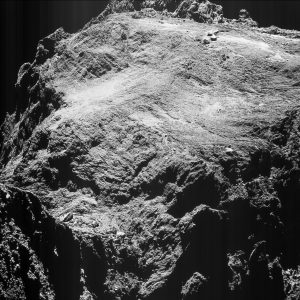Xenon isotopes in 67P/Churyumov- Gerasimenko show that comets contributed to Earth’s atmosphere
B. Marty, K. Altwegg, H. Balsiger, A. Bar-Nun, D. V. Bekaert, J.-J. Berthelier, A. Bieler, C. Briois, U. Calmonte, M. Combi, J. De Keyser, B. Fiethe, S. A. Fuselier, S. Gasc, T. I. Gombosi, K. C. Hansen, M. Hässig, A. Jäckel, E. Kopp, A. Korth, L. Le Roy, U. Mall, O. Mousis, T. Owen, H. Rème, M. Rubin, T. Sémon, C.-Y. Tzou, J. H. Waite, P. Wurz
June 2017. Science Vol. 356, Issue 6342, pp. 1069-1072
doi: 10.1126/science.aal3496
Rosetta finds comet connection to Earth’s atmosphere

The challenging detection, by ESA’s Rosetta mission, of several isotopes of the noble gas xenon at comet 67P/Churyumov–Gerasimenko has established the first quantitative link between comets and the atmosphere of Earth. The blend of xenon found at the comet closely resembles U-Xenon, the primordial mixture that scientists believe was brought to Earth during the early stage of the Solar System formation. These measurements suggest that comets contributed about one fifth of the amount of xenon in Earth’s ancient atmosphere.
Picture: Rosetta navigation camera (NavCam) image taken on 15 May 2016 at 9.88 km from the centre of comet 67P/Churyumov-Gerasimenko. The image measures 862 m across and has a scale of about 0.84 m/pixel.
These observations were performed in a three-week period during which Rosetta flew very close – 5 km to 8 km from the surface – so that ROSINA, the Rosetta Orbiter Spectrometer for Ion and Neutral Analysis, could search for the noble gas xenon, an important tracer of the early Solar System’s composition.
This challenging operation was necessary to obtain a significant detection of several isotopes of xenon. As a result of the observations, ROSINA
identified seven xenon isotopes as well as several isotopes of another noble gas, krypton.
